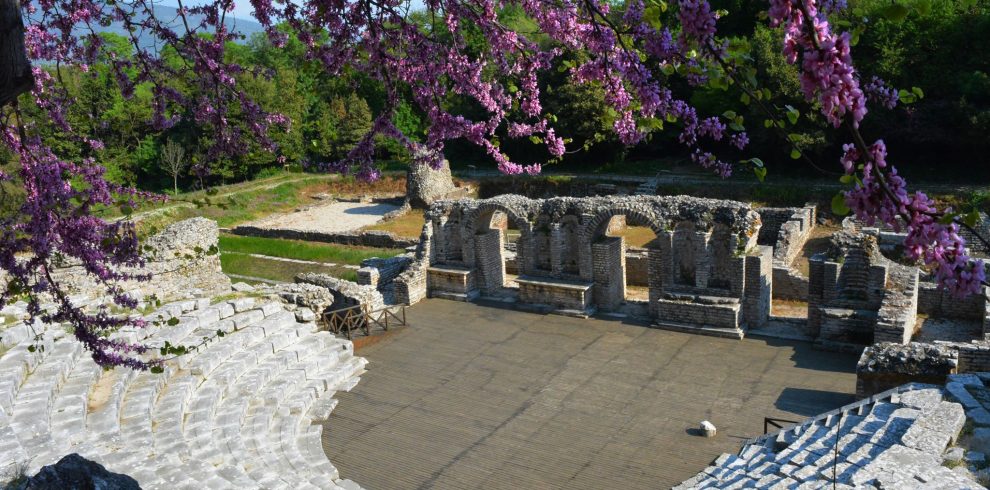Itinerary: Berat-Gjirokaster-Butrint-Sarande-Vlore-Durres
Albania is a country of rich civilization dating back several millennia BC, whose traces are still very clear today in numerous archaeological sites. In ancient times the entire Western Balkans was called the Illyrian Peninsula. Subsequently influenced by the Byzantine civilization of the Ottoman occupation, other cities were built and remained as evidence of the different periods that overlapped the Illyrian traces. Today some of them are UNESCO World Heritage Sites. But Albania also has very rich spiritual heritage, its songs, dances, customs and traditions have rare values, such as Isopoliphony, which is also included in the UNESCO World Heritage Site.
Meet and assisted by our guide in arrival, transfer to Berat,which is known as “the city of “one over another windows” to make known the 2400 years of history, testimonial of which is the castle built on the hills of the city. Inside the walls of the castle you will visit a lot of tourist objects such as: the Onufri Iconographic museum, Saint Trinity church, enclosed by 20 smaller churches.. The lovely painted Mosque of the Bachelors and the Tekke of the Helvetis with its beautiful portico. The visit proceeds to the museum quarters of Mangalemi and Gorica. After, accoriding to time left, we can visit the Ethnographic Museum, the Jewish Museum, a brand new one in the city etc. Accommodation in one of the old-houses hotels in Mangalem or Gorica.
After breakfast, visit at the fortress of Gjirokastra, built in 4-th century, the National museum of Weapons, The Cold War Museum, the church in the old Bazaar, the characteristic shops of Gjirokastra. You can see the artisans while they work on their crafts and perhaps by an instant personalized souvenir, carved in stone.
On the way to Saranda, visit to the Mesopotamian Monastery, Saint Nicolas church which belongs to Byzantine period and the old residual of the ancient city of Foinike.
Continue to Saranda city. Accommodation in 4* hotel. Dinner and overnight in Saranda.
After breakfast, transfer to National Archaeological Park of Butrint, an UNESCO World Heritage site since 1992. The site has been inhabited since at least the 8-th century BC.
The Roman Emperor Augustus founded a colony at Butrint and the town seems to have remained a relatively small roman port until the 6th century AD. Its later medieval history was turbulent as the town was involved first in the power struggles between Byzantium and successive Norman, Angevin and Venetian states, and then in the conflict between Venice and the Ottoman Turks. One of the most noteworthy monuments in Butrint is the elegant Greek 4-th century BC theater with its well-preserved seats and Roman stage, which has a capacity for over 1,500 spectators and is still used for summer performances today. Other remarkable objects of interest include the sanctuary of Asclepius; Roman-period courtyard houses and bath-houses; the ruins of a large Byzantine baptistery with its intact mosaic dating to the early 6th century AD; a well-preserved 6th century basilica, later refurbished in medieval times.
The Trip continues up to the Albanian Riviera. We will make a stop at a panoramic restaurant near the sea shore where you can taste lunch with sea products according the traditional Albanian cooks. In the afternoon arrival in Vlora, a historical and coastal city. Accommodation in 3*, 4* hotel. Dinner at the hotel. Overnight in Vlora.
After the breakfast we will proceed to the archaeological park of Apollonia in Fier. The city achieved its maximum development in the 4th – 3rd centuries B.C. In the first century B.C., Octavian Augustus studied philosophy there until he heard news of Caesar’s murder in the Senate and went on to become the next Roman emperor.
Stopover in Ardenica Monastery, where is told to been held the wedding of our national hero Scanderbeg, with its young wife Donika, from Arianiti Family of Vlora.
After lunch we will proceed to the ancient city of Durres, that is also the most important seaport in Albania. Visit the Archaeological Museum and the Amphitheatre, the biggest in the Balkan Peninsula (capacity 20.000 spectators) with a rare wall mosaic, which belongs to the 2nd century A.D. Accommodation in 4* hotel. Dinner and overnight in Durres.
After breakfast at the hotel, free time at leisure until departure. Transfer to departure from Albania.

